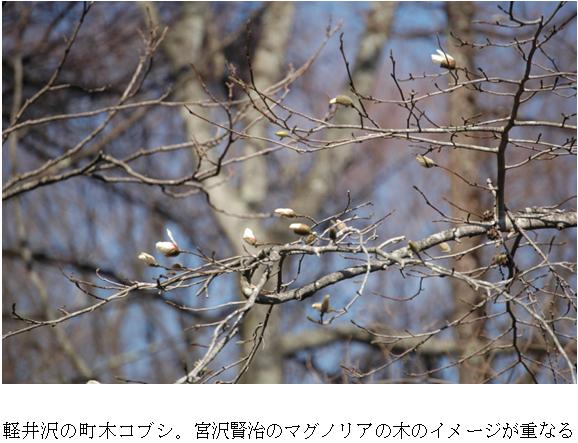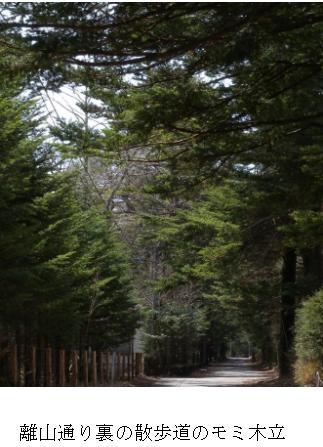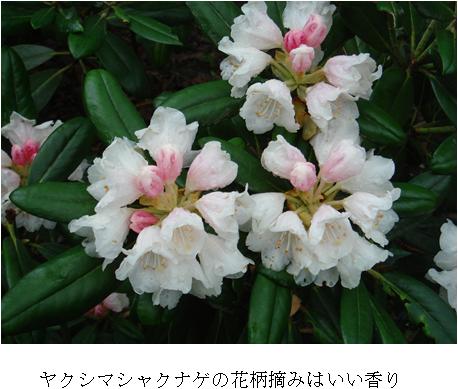
2003年の春、いまから9年前のちょうどこの時期、パートナーと私は、ふと思い立って、生まれて初めて軽井沢を訪れました。もちろんこの地が避暑地として有名であることは知ってはいましたが、特に軽井沢という土地に魅力を感じることもなく、縁遠い存在として訪れる機会もありませんでした。
事前の下調べもほとんどせずに、ふらっと訪れ、こじんまりしたペンションに宿泊しました。人影もまばらで、足元も春のぬかるみで歩きにくく、まだ草木も芽生えぬ時期ですが、凛とした冷たい空気が気持良く、静かで素朴な土地に不思議な魅力を感じました。

たまたま、軽井沢の離山(はなれやま)通りの裏にある静かな別荘地の木立を散歩していたとき、どこからともなくとてもいい香りがしました。
ハッカのようにすっきりとさわやかでいながら、すこし甘酸っぱいような香りです。あたりには針葉樹の茶色くなった葉がたくさん積もり、頭上には大きなモミの木や、さまざまな落葉樹の枝が広がっています。
たくさんの小鳥の楽しそうな声が、そこかしこから聞こえてきます。まだ誰もいない別荘の庭の地面を柔らかそうなスギゴケが覆い、明るい陽だまりとなって輝いています。遠くの家のストーブの煙突からは、薪を焚く香ばしい煙がゆらゆらと上っているのが見えます。
この不思議な香りは、一体どこから来るのでしょう・・・。
いい香りの記憶は、静かな木立やにぎやかな小鳥たちの声、明るい日差しと渾然一体となって「気持ちよい」という感覚とともに奥深く沈んでいきました。
その香りの記憶に導かれたのか、縁あって私どもは離山通りの近くに住むこととなりました。そしてのちに、ソフィアート・ガーデンを作っていく際にも「香り」というキーワードは私にとってとても大切なものになりました。
四季折々に、その季節だけに許された自然の放つ良い香りを、存分に味わいたい。木だけではなく、もちろん草花も土も含めて、自然界の香りの豊かさを思うと、嬉しくなります。
ガーデンには、5~10メートル程度のウラジロモミが10本ほどあります。そして、初めて軽井沢の木立を散歩したときに包まれた、あのハッカのようにすっきりとさわやかな香りと同じ香りを、時々漂わせています。
特に台風の後などには、ヒノキやレモンのような清涼感のある香りもします。モミの枝が強風で傷つき、自らの樹液(ヤニ)で治癒をしようとしているのでしょうか。

また25メートルほどの樹齢およそ70年のカラマツも複数あります。ガーデンに建屋を建てるときの材に使うために、数年前に8本ほど切りましたが、ガーデンに連なる雑木林にはたくさんのカラマツがありますので、晩秋にはサラサラと霧雨のように黄色い落葉が降り注ぎます。「落葉松」という名前どおりです。
このカラマツの落葉は大地に積もり、静かに自然界の微生物や酵母による熟成を受け、春にはやがて甘酸っぱいような良い香りをあたりに漂わせていきます。
ところでカラマツの樹液(ヤニ)は無色透明で粘着性が高く、においも触った感じもセメダインに少し似ています。大工の棟梁さんから教わったのは、佐久地方ではカラマツのヤニを小瓶に集めておいて、切り傷などに塗れば殺菌作用もありすぐに治る、ということです。一度私も手に塗ってみましたが、あまりのベトツキで手仕事がはかどらずに往生しました。しかし、病み付きになるカラマツのヤニの香りでとても楽しめました。
ガーデンには、良い香りの代表ともいえるカツラの木も何本かあります。秋のある日、綿菓子のような甘いカラメルの香りが漂うと、はっとカツラの黄葉に気づかされます。
戸隠神社の奥社にお参りする途中にもカツラの大木があり、秋の日には思わず、できるだけ息をたくさん吸って、辺りに漂う甘い香りを食べ尽くしたくなるような楽しさです。

ガーデンに自生するコクサギのツヤツヤの葉をちぎると、柑橘系の香りが楽しめます。
ヒカゲツツジやエゾムラサキツツジの花柄を摘むと、ゼラニウムのエッセンシャルオイルよりもいい香りが指に染みこみます。
もちろんスイセンの花やウメの花もすばらしい。
ガーデンに自生するアサツキを摘んでお吸い物に散らすと、ネギ特有の香りが立ちます。
夏には霧の中の白いウバユリの群生から芳香が漂い・・・と、「香り」については、まだまだ書き足りませんが、きりがありませんので続きはまた今度にいたします。
『 ソフィアート・ガーデン物語 』 第3話 「木の香り」
有限会社ソフィアート スタッフM( 竺原 みき )
関連する物語
>> 第3話「木の香り」
>> 第34話「生命の木」
>> 第73話「軽井沢に住む」
The Tale of Sophiart Garden
>>To the Previous Story | >>To the Next Story
Chapter 3
“The Scent of Trees”
April 12, 2012
It was the spring of 2003, exactly nine years ago, when my husband and I—on a whim—visited Karuizawa for the first time in our lives.
Of course, I had always known of Karuizawa’s fame as a summer retreat. Yet, I had never felt particularly drawn to the place, nor had I ever had a reason to visit.
Without much prior research, we set off on a spontaneous trip and stayed in a small, cozy pension. The town was quiet, with few people around. The ground was still damp and muddy from early spring, and the trees had yet to awaken from their winter slumber. Yet, the crisp, cold air was invigorating, and there was something profoundly calming about the simple, unadorned landscape.
A Mysterious Scent in the Forest
As we wandered through a quiet villa neighborhood tucked behind Hanareyama Street, a fragrance—subtle yet captivating—drifted through the air.
It was refreshingly crisp, like peppermint, yet carried a faintly sweet and tangy note.
The ground beneath our feet was layered with brown needles from coniferous trees, while above us, towering firs and bare branches of deciduous trees reached for the sky. The cheerful chatter of birds filled the air.
In the yards of unoccupied villas, soft carpets of cedar moss glowed warmly in the dappled sunlight. In the distance, wisps of fragrant wood smoke curled from the chimney of a home, rising lazily into the sky.
Where had that intriguing scent come from?
That moment—the scent itself, the quiet rustling of the trees, the lively chirping of birds, and the gentle touch of sunlight—sank deep into my memory as a feeling of pure contentment.
A New Life Shaped by Scent
Perhaps it was this lingering memory that guided our path, for we eventually found ourselves settling near Hanareyama Street. Later, as we began to create Sophiart Garden, the idea of scent became a fundamental part of its design.
I wanted to fully embrace the fleeting fragrances that nature offers with each season—not only from trees but also from flowers, earth, and the air itself. The sheer richness of these natural aromas fills me with joy.
The Trees That Breathe Fragrance
The garden is home to about ten Urajiro-momi (Veitch’s silver fir) trees, ranging from five to ten meters in height. Every now and then, they release the same fresh, mint-like scent I first encountered during that fateful walk in Karuizawa.
After a storm, the air takes on a crisp, clean fragrance, reminiscent of cypress or lemon. Perhaps the fir trees, wounded by the fierce winds, are releasing their resin to heal themselves.
We also have several Karamatsu (Japanese larch) trees, some towering at 25 meters, their age estimated at around 70 years. When we built the structures within the garden, we had to cut down about eight of them for lumber. Even so, the surrounding woodland remains abundant with larch, and in late autumn, their golden needles rain down like a fine mist—true to their name, which literally means “falling-leaf pine.”
These fallen larch needles slowly decompose, aided by microbes and yeast in the soil, and by spring, they release a delicate, sweet-tart fragrance that drifts through the air.
The Essence of Larch and Other Fragrant Trees
The resin of the larch is clear, highly sticky, and carries a scent somewhat reminiscent of glue. A master carpenter once told me that in the Saku region, people collect larch resin in small bottles and use it as an antiseptic for cuts and wounds.
Curious, I tried applying it to my hand once. While its adhesive nature made it impractical for working with my hands, I couldn’t help but enjoy its uniquely addictive scent.
Among the many trees in the garden, Katsura (Japanese Judas tree) is perhaps the most renowned for its fragrance.
On certain autumn days, the air fills with the sweet, caramel-like aroma of cotton candy, signaling the turning of the Katsura leaves.
Deep in the mountains of Togakushi Shrine, a massive Katsura tree stands along the path to the inner sanctuary. In the crisp autumn air, I always find myself instinctively taking deep breaths, trying to absorb as much of the delightful sweetness as possible.
A Symphony of Natural Aromas
Breaking a glossy leaf from a wild-growing Kokusagi (Skimmia) in the garden releases a bright citrus scent.
Plucking the spent flowers of Hikage-tsutsuji (Shady Azalea) or Ezo-murasaki-tsutsuji (Ezo Purple Azalea) leaves a fragrance on my fingertips even richer than geranium essential oil.
Of course, the blossoms of narcissus and ume (Japanese apricot) are magnificent in their own right.
And when I scatter freshly picked Asatsuki (wild chives) into a simple broth, the sharp, green aroma rises with the steam.
In summer, a misty haze drifts through the garden, carrying the gentle perfume of white Ubajiri lilies blooming in clusters.
There is so much more I could say about the scents that fill the garden—but perhaps that is a story for another time.
—
The Tale of Sophiart Garden
Chapter 3: “The Scent of Trees”
Miki Jikuhara, Sophiart Karuizawa
>>To the Previous Story | >>To the Next Story





